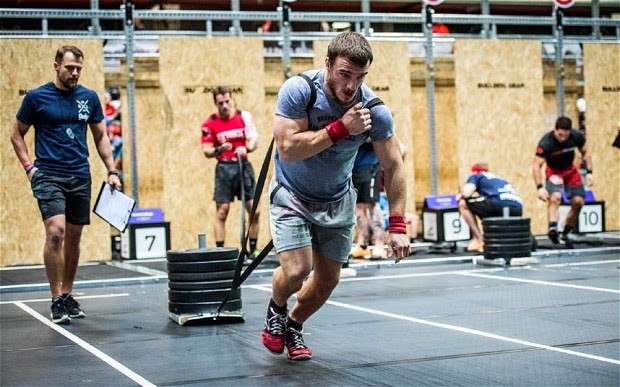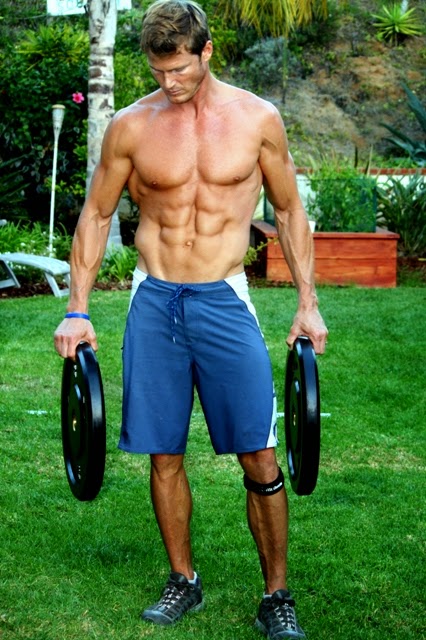Q: Is it possible to get uber fit exercising only 20 minutes a day?
A: No.
However, 20 minutes a day is certainly
better than nothing, and it might be just enough activity to maintain your health
and improve longevity. As a society we
seem busier than ever, but we’re also getting way smarter about how to train, and
weve finally realized just how darn important consistent exercise is. In fact exercise is critical to our health,
on par with nutrition and 2nd only to sleeping well. People who exercise consistently, live longer
than those who don’t, given all else being equal. Only your genetics play a greater role in life
span. We now know that some of that time spent exercising ideally needs to
push into (relatively) higher intensity levels. But just how intense do we need to go? Is there an intensity or volume threshold to
where there is no more benefit? The key
for all of us busy folks, is to find the sweet spot where training time intersects
with intensity level, which triggers the most benefit. I call this maximizing your exercise value.
There’s a certain niche of neo-athletes that have embraced training
so much that they've declared “fitness to be its own sport”, never mind a
lifestyle. A sub-culture of every day
citizens who walk among us that have discovered their inner athlete and have
taken training to a whole other level. I’m
not talking about bodybuilders or triathletes here – that’s old school. I’m talking about well-rounded fitness aficionados
that desire to be total athletes by combining full-body-functional, cardio and
strength exercises. I’m talking about
the present day Boot-camper, SEAL-Fitter, CrossFitter, Tough-Mudder, Spartan genre
who whole-heartedly decided that just because they have families and careers,
doesn't mean they can’t be uber athletes too.
They've revealed their inner-warrior and when you see them training
together, feeding off each other, you get a sense there’s something special
going on there, almost like a religion, or a tribe of warriors. - Some kind of competitive, comradery dynamic,
testing themselves with exciting, yet effective exercises, that arouses your
curiosity. There’s a synergistic magic
happening there in part from the group dynamic.
Maybe I’m describing one of your close friends or even you. There’s a reason why these folks are
experiencing these powerful physical and mental transformations no matter what
their age is, in a relatively short amount of time. They've found out how to maximize their
exercise value in a competition based, group dynamic that comes with its own
band of brothers for support. They
become training addicts…and it’s not the mirror they’re addicted to. You watch these guys and it almost feels as
if they've never had so much fun being tortured. They have even created niche competitions to
help motivate them to take their training goals to the next level and they have
indeed declared that fitness in and of itself, can stand alone as its own
sport.
Even if this genre of group
training is not for you – perhaps you’re more of the solo type - we can all benefit
from many effective training principles they have sifted out for all of us. They might not have invented high-intensity
training in the traditional sense, but these neo uber-athletes have embraced it
and put it to the test like no other generation before us. Their results have spoken loudly. I
invite you to stay with me a bit longer to learn about some of these high
intensity training principles, how they came about, how to employ them, and why
they are key to maximizing your exercise value. But first we need to travel back in time a
bit, to the days of zone training…
Remember a little over a decade
ago, when fat-burning-zone training
was the latest and greatest trend, as the best method to get lean? It was basically endurance-type training,
where you purposely stayed in an aerobic-cardio
zone in attempt to access stored fat as the primary fuel, and the longer and
slower the better. I remember, everybody
was training with a heart rate monitor to ensure they were training in the
correct ‘zone’, in this case the aerobic/fat-burning zone, so no matter what
folks didn’t want to exceed 80% of their maximum heart rate – because that is
where, in theory at least, you might cross over into the anaerobic zone - oh my! It
was like everybody was training to become a triathlete or marathoner, one-size-fits-all
approach, with all these long zone workouts they were slogging through. Looking back now, we’ve pretty much all
switched our training (heart rate) ‘zones’ 180 degrees. And for good reason: We placed the emphasis on exercise value – none of us had
that many hours in the week available to train! These days we demand the most bang for our buck because we are busy…uber
busy! And we want to be strong. We want to be able to hoist barbells above
our heads, and swing kettlebells and do muscle-ups or at least real SEAL style
pull-ups. And we no longer want to look
like skinny, frail marathoners. Skinny implies
weak. We want our physiques to look like men of lore – like Spartans, and
Navy SEALS. We want our bodies to
perform like MMA warriors who can defend ourselves and protect our families –
high functioning, quick and powerful.
Yes, those were some ridiculous
times, a 15 years or so ago – suffering through all that long, slow, boring
aerobic-cardio training to try and single out fat for fuel – which is nearly impossible
to do, unless in ketosis. The irony being, we may have been getting
leaner but we were also simultaneously catabolizing a heck of a lot of precious
muscle!
Zone-training just to get lean, is almost as silly as back in the
80s when we thought we could eat all of the carbohydrates we wanted as long as
we avoided fat. We just didn’t have a
grasp on the powerful role of the insulin shuttle-hormone back in the 80s,
until Dr. Atkins came along and shifted the carbohydrate/insulin paradigm and shed
a new light on carbs’ role in gaining fat.
Of course he unnecessarily villainized them. Now we’re much smarter. We’ve realized we need to do just the
opposite and train at very high intensity levels – uber high intensity levels –
if we want to get uber fit and lean, while protecting and even building
additional muscle mass. And what’s more,
at such extreme intensity levels, we don’t need to train for nearly as long,
thus maximizing our exercise value. For sure slow, endurance training has its
place if you’re an endurance athlete, obviously. But if you’re a working man, husband and
father, who barely has time to eat breakfast, then you are truly able to
benefit from today’s shorter, higher intensity workouts. Classic, vetted examples of these type of
workouts are, High-Intensity Interval Training (HIIT), Boot-Camp, Navy SEAL-inspired
training, CrossFit, and P90X.
It was around the year 2000 or so
that we started seeing boot camp and
SEAL inspired workouts becoming more popular, as well as studio spin
classes. This was the beginning of the
high-intensity training revolution.
Shortly after came CrossFit,
then Beachbody’s P90X by Tony Horton. Also
during this time, generic High-Intensity
Interval Training was being employed by many Personal Trainers as well as
phsyique athletes and fitness models desiring to get ultra-lean while avoiding
the risk of muscle catabolization associated with longer cardio workouts. Workouts such as hill running intervals,
sprint intervals, plyometrics, stair-running, etc., that had a working interval
followed by a resting interval, usually in a 1:3 ratio of working to resting
time respectively. The ideology being
that you were working up to maximum effort and even failure during the
working interval, and thus had to have a recovery interval immediately following. In fact that is the key common principle in all high-intensity workouts: They require that you push to maximum effort
and hit failure, (either aerobic or anaerobic, or both) – that is where
their physiological, physique transforming magic happens, and that is where they
earn their effectiveness that allows them to be so much shorter in
duration. Because when you hit physical
failure, (typically associated with heavy breathing, lactic acid-accumulation-burning
and/or ATP depletion), repeatedly in a short time period – a lot of neat stuff
starts to happen within your muscles and entire body – results start to
happen! Growth Hormone secretes,
testosterone levels rise, insulin sensitivity improves, glucose-tolerance
improves, your liver dumps glycogen and fatty acid stores, micro-trauma occurs
in the muscle fibers triggering anabolic repair and growth, and you get
completely depleted – an amazing feeling.
So much so, that your resting-metabolism becomes elevated for several
hours after the workout is over and any food you eat post-workout gets sucked
up for recovery, repair and stored as intra-muscle glycogen and not as fat. This
extended recovery period is known as EPOC or, Excess Post-exercise Oxygen Consumption.
But here’s the final, gleaming
nugget of truth I’m trying to leave you with regarding exercise value, and just
how precisely short of duration can be effective, regardless of how intense you
think you can push yourself. There’s
this notion that if you go intense enough you can see results in just 20
minutes. But there are some caveats that
go along with that ideology. First off,
you have to already be in a reasonable state of health and fairly fit to begin
with to train at very high intensity levels, and you should begin in the
presence of a Trainer and wear a heart rate monitor. Secondly, the 20 minutes often claimed by
some of the WODs (workout-of-the-day), typically does not include the mandatory
time spent warming up, nor any time spent learning technique for the more
difficult exercise movements. Many of
the these high intensity programs such as CrossFit, have a steep learning curve
associated with them, as they include some very advanced and technical
exercises, some involving Olympic-style barbell overhead lifts. Some of these advanced exercises take months
to perfect. If you ever been into a
CrossFit gym, or a ‘Box’, you would know that they also incorporate a coaching
element after the warm-up and prior to the workout, thus your time in the gym
has now reached a full hour. Warming up
and loosening up is very critical for high intensity training across the board
because you tend to be performing very quick, bursts of powerful movements
which inherently increase risk of injury if not done properly or not warmed
up.
So yes, there are a lot of caveats
and things to consider before you just go balls-to-the-wall for your 20 minutes
of high-intensity magic. You have to
know what you’re doing, maintain perfect form, and by all means loosen up and
warm-up. And if you truly are planning
on pushing to failure, either aerobic or anaerobic, you should definitely begin
by getting a physical assessment from your trusted health professional, and,
train while wearing a heart rate monitor.
Hear rate monitors give you the bottom line on intensity level and will
validate your perception. You can get
fit and improve longevity in just 20 minutes a day, but if you want to get uber
fit – you need to put in at least an hour a day! Cheers to my fellow fitness aficionados, uber
athletes, and working warriors out there – I’m right there with all of you!
-
Max












The goal of the hospitals was to do inpatient admissions, fill up the beds and more emphasis was given to acute inpatient care. The role of managers in the old paradigm was to run the organization and coordinate services. is jimmy john's good for diabetics
ReplyDelete